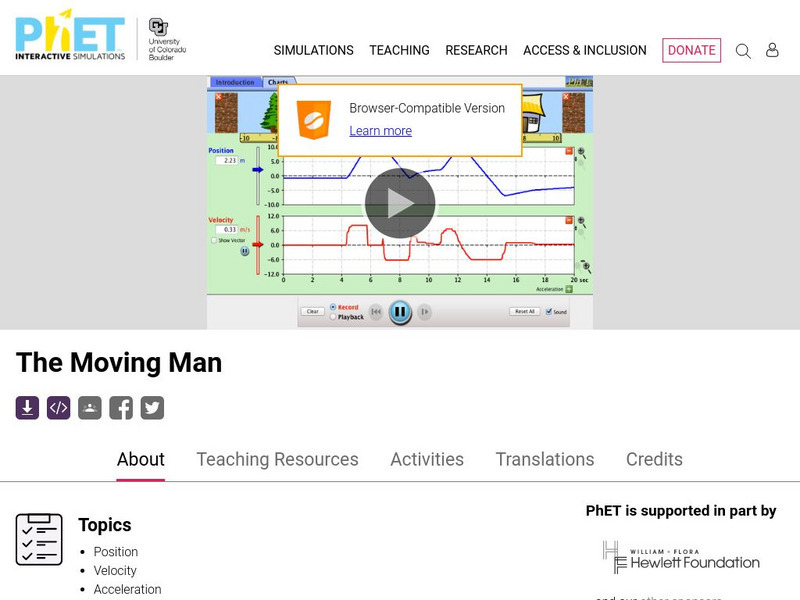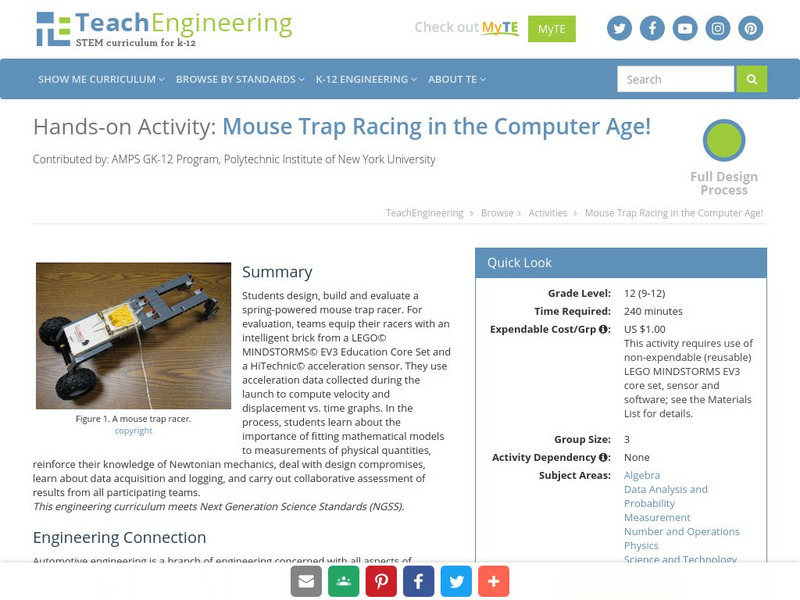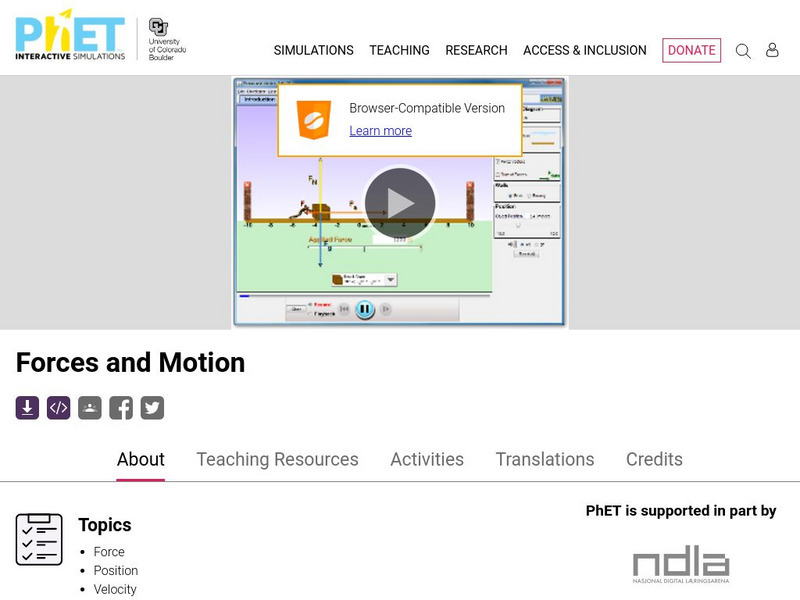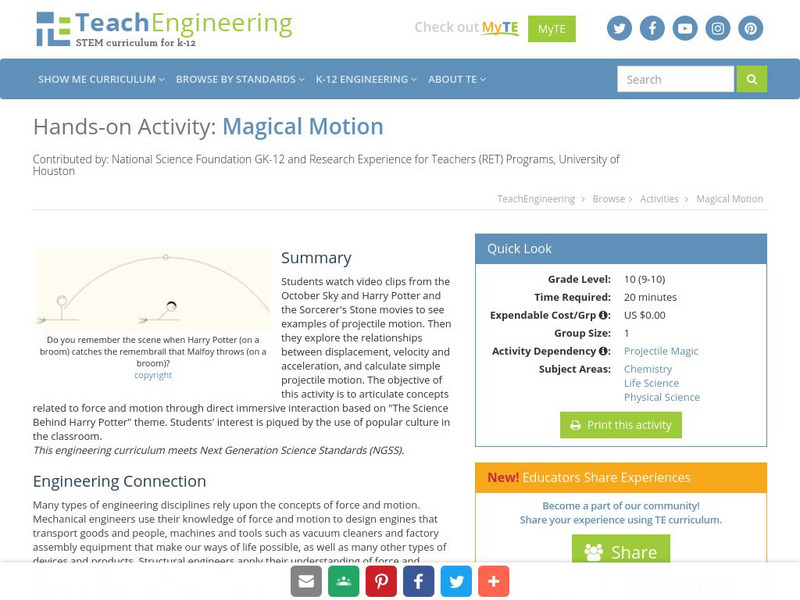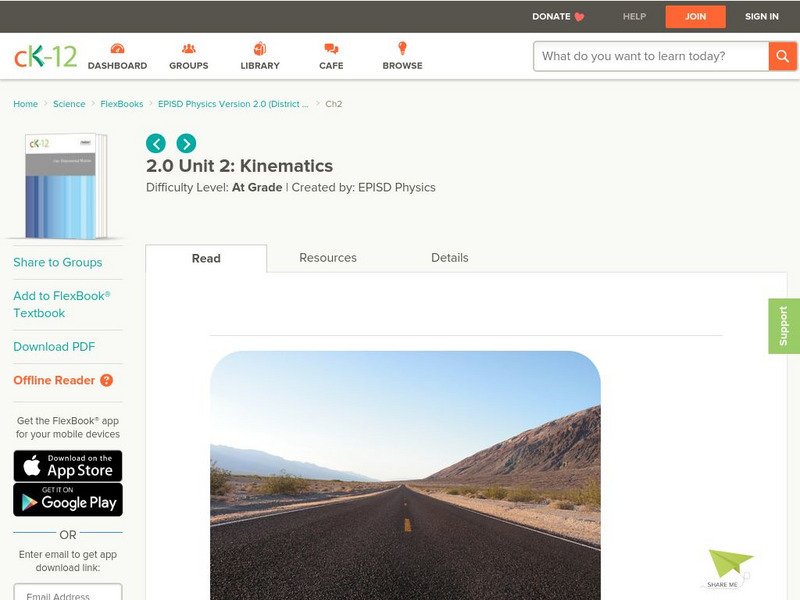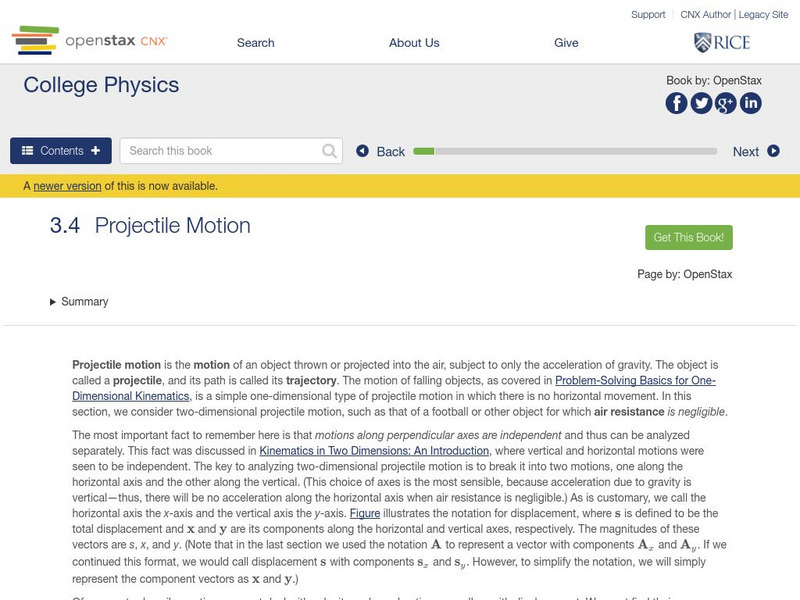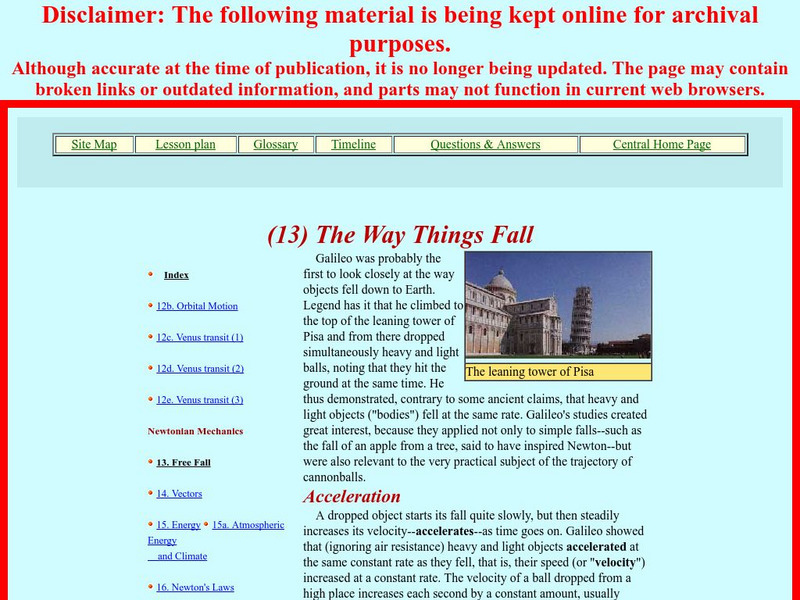University of Colorado
University of Colorado: Ph Et Interactive Simulations: The Moving Man
Learn about position, velocity, and acceleration graphs. Move the little man back and forth with the mouse and plot his motion, and then set the position, velocity, or acceleration and let the simulation move the man for you.
TeachEngineering
Teach Engineering: Mouse Trap Racing in the Computer Age!
Students design, build and evaluate a spring-powered mouse trap racer. For evaluation, teams equip their racers with an intelligent brick from a LEGO MINDSTORMS NXT Education Base Set and a HiTechnic acceleration sensor. They use...
University of Colorado
University of Colorado: Ph Et Interactive Simulations: Ladybug Motion 2 D
Manipulate a ladybug's position, velocity, and acceleration, and see how the vectors change in this interactive simulation. Software download is necessary.
University of Colorado
University of Colorado: Ph Et Interactive Simulations: Forces in 1 Dimension
Explore the forces at work when you try to push a filing cabinet. Create an applied force and see the resulting friction force and total force acting on the cabinet. Charts show the forces, position, velocity, and acceleration vs. time....
University of Colorado
University of Colorado: Ph Et Interactive Simulations: Forces and Motion
Explore the forces at work when you try to push a filing cabinet. Create an applied force and see the resulting friction force and total force acting on the cabinet. Charts show the forces, position, velocity, and acceleration vs. time.
TeachEngineering
Teach Engineering: Magical Motion
Students watch video clips from the October Sky and Harry Potter and the Sorcerer's Stone movies to see examples of projectile motion. Then they explore the relationships between displacement, velocity and acceleration, and calculate...
TeachEngineering
Teach Engineering: Physics of the Flying T Shirt
Students are introduced to the physics concepts of air resistance and launch angle as they apply to catapults. This includes the basic concepts of position, velocity and acceleration and their relationships to one another. They use...
CK-12 Foundation
Ck 12: Episd: Physics: Kinematics
[Free Registration/Login may be required to access all resource tools.] An online chapter focused on motion and the shapes it takes. Topics range from speed and velocity to acceleration and free fall. Find detailed visuals, learning...
CK-12 Foundation
Ck 12 Exploration Series: Simulations: Physics: Irwin 2 D
[Free Registration/Login Required] Learn about the trajectories in two dimensions through simulation and examples. Some of the concepts identified are motion and velocity.
Khan Academy
Khan Academy: What Are Position vs. Time Graphs?
What can you learn from graphs that relate position and time and how are they useful? Article relates what the verticle axis, slope, and curvature represents on a position graph and provides examples.
Khan Academy
Khan Academy: What Are the Kinematic Formulas?
Featured are the kinematic formulas or main equations you can use to analyze situations with constant acceleration.
OpenStax
Open Stax: Projectile Motion
The following interactive helps students understan how to identify and xplain the properties of a projectile, such as acceleration due to gravity, range, maximum height, and trajectory. They will determine the location and velocity of a...
TeachEngineering
Teach Engineering: Projectile Magic
Learners watch video clips from October Sky and Harry Potter and the Sorcerer's Stone to learn about projectile motion. They explore the relationships between displacement, velocity and acceleration and calculate simple projectile...
University of Colorado
University of Colorado: Ph Et Interactive Simulations: Torque
Experiment how torque causes an object to rotate. This interactive simulation shows how angular acceleration, moment of inertia, angular momentum, and torque relate to one another.
TeachEngineering
Teach Engineering: Projectile Motion
Students are introduced to the concept of projectile motion, of which they are often familiar from life experiences,such as playing sports such as basketball or baseball, even though they may not understand the physics involved. Students...
NASA
Nasa: Beginner's Guide to Aerodynamics
This site from NASA uses a colorful graphic to illustrate why objects reach terminal velocity. Provides equation for the terminal velocity of an object. Graphic is accompanied by a simple explanation.
Department of Defense
Do Dea: Working With Parabolic Projectile Paths
Using the free-fall constants and gravity acceleration equations, we can determine many things about the position, velocity, and speed of a projectile. Here are a few examples and explanations. This is a great review for the AP Calculus...
Walter Fendt
Walter Fendt: Simple Pendulum
This app demonstrates how elongation, velocity, tangential acceleration, force, and energy are affected when a pendulum oscillates.
Walter Fendt
Walter Fendt: Movimiento Con Aceleracion Constante
A short interactive activity which allows you to visualize a constant acceleration. You can modify the initial position, the initial velocity and the acceleration.
NASA
Nasa: The Way Things Fall
This site from NASA compares free falling motion to falling with air resistance. Discusses Galileo's experiment. Explains why we believe all objects free fall with the same acceleration.
Physics Classroom
The Physics Classroom: Motion/forces in Two Dimensions: Projectile's Trajectory
This illustrated tutorial discusses the horizontal and vertical components of a projectile's motion; specific attention will be given to the presence/absence of forces, accelerations, and velocity.
Department of Defense
Do Dea: Free Fall Constants for Earth
When you work with equations that show position, velocity, acceleration of objects that are flying or falling through the air, you will be using the constant that is the acceleration due to gravity. View formulas, explanations, and...
Georgia Department of Education
Ga Virtual Learning: Ap Physics 1: One Dimensional Kinematics
Using only two of our fundamental units, time and displacement students will build a framework to predict the motion of objects, starting with one dimensional motion.
Stanford University
Stanford University: Conventionality of Simultaneity
This site from Stanford University is on the topic of simultaneity in relativity.
Other popular searches
- Speed Velocity Acceleration
- Velocity and Acceleration
- Velocity Acceleration Lab
- Velocity Acceleration
- Speed, Velocity, Acceleration
- Velocity Acceleration Force
- Physics Velocity Acceleration
- Velocity Acceleration Graph
- Motion Velocity Acceleration
- Speed/ Velocity/ Acceleration
- Velocity Acceleration Momentum
- Velocity & Acceleration


